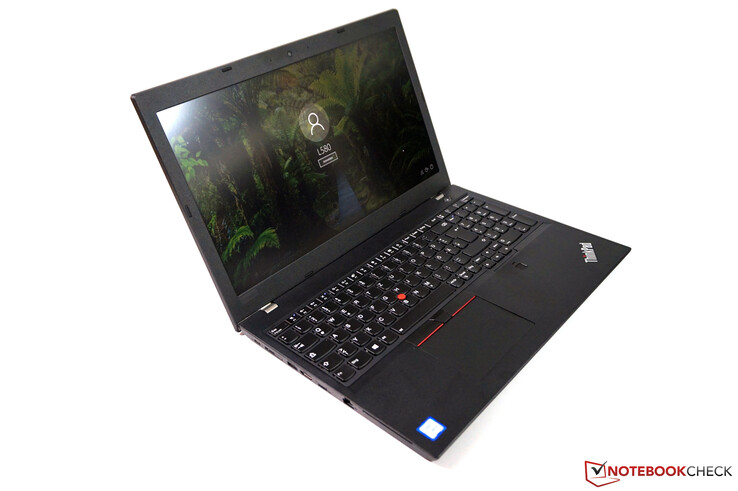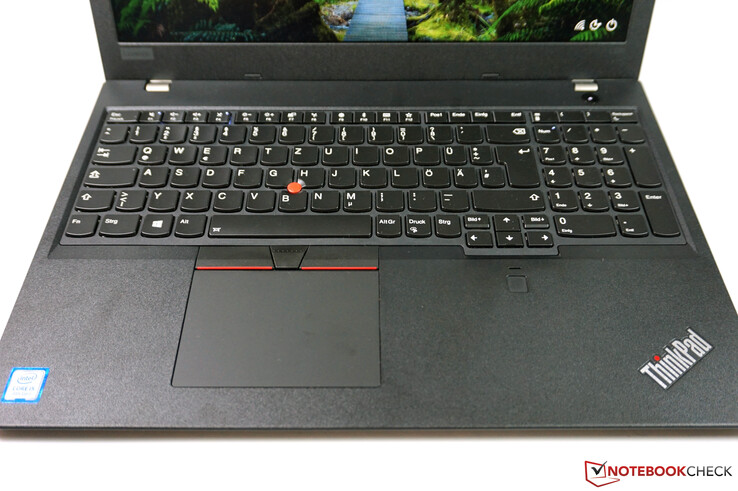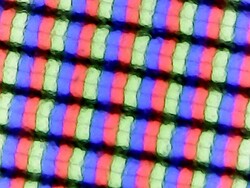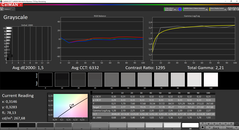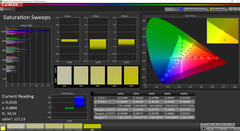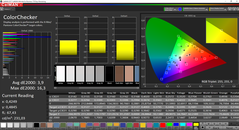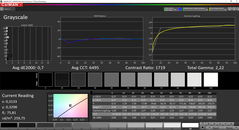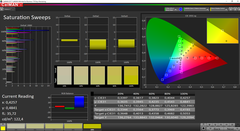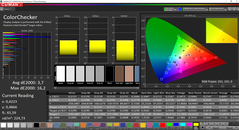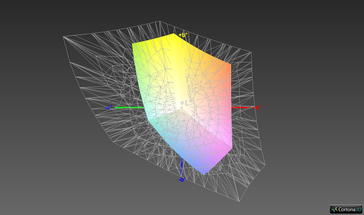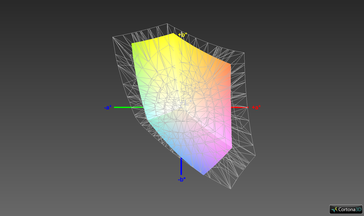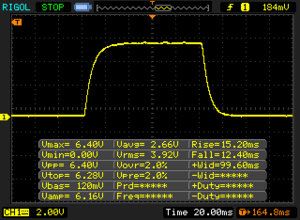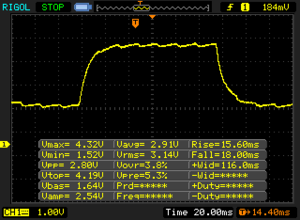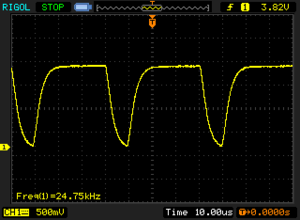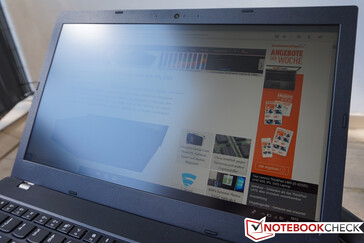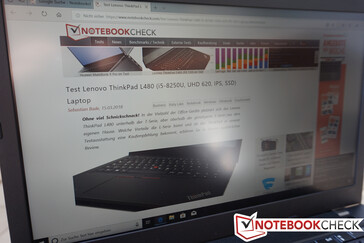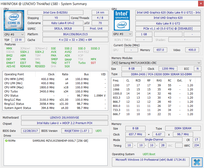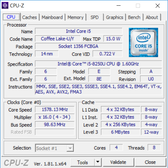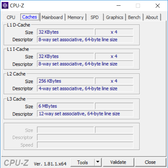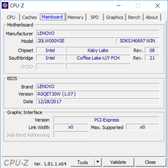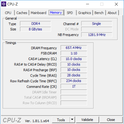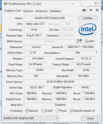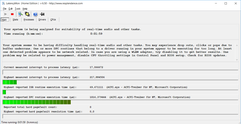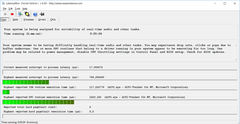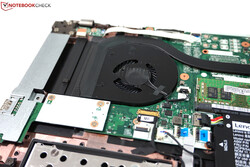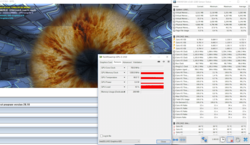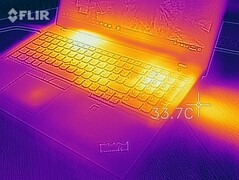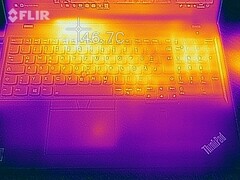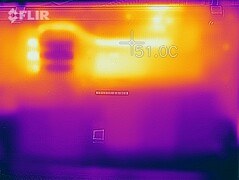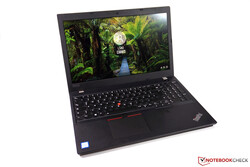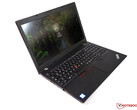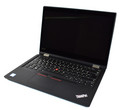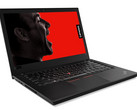Lenovo ThinkPad L580 Laptop Review: Reliable office notebook with a good keyboard

With the ThinkPad L-series, Lenovo offers affordable office devices for everyday office tasks. In the past, these solid laptops often went without the latest features, but still offered some things that you could not find in higher-range laptops anymore, such as a VGA port or an optical drive. With the L580, Lenovo has slightly changed its tactics and aligned the device more with its other siblings. The advantages are a significantly lighter case and the support of the current docking stations via the side-dock connection.
Our test unit of the ThinkPad L580 carries the label 20LW000VGE and costs around 900-930 Euros (~$988-1021; $739 in the US) in stores. Students can get it for about 60 Euros (~$66) less. For that, you get a Core-i5 processor, 8 GB of RAM, and a 256 GB NVMe SSD. The 15.6-inch display (IPS) supports the Full HD resolution and has a matte surface. The competition among office laptops is particularly intense in the lower price range. In addition to the L570 direct predecessor, we will use the following devices for our comparison: Acer TravelMate P2510, HP ProBook 450 G6, and Lenovo ThinkPad E590.
Case and Equipment
The greatest change happened in the case, since the Lenovo ThinkPad L580 has become significantly slimmer and lighter compared to its predecessor. On the other hand, it had to forgo for example the optical drive for this. In terms of the design, the black case with the silver lettering and red accents is immediately recognizable as a ThinkPad, and at first glance it remains indistinguishable from its more expensive siblings.
Unlike the more expensive models, only plastic is used in the ThinkPad L580 case. The top of the base unit feels particularly rough. Fortunately, this cost-cutting measure has no effect on the stability during everyday use, and the base unit as well as the lid are stable. The two hinges perform their task reliably and are able to prevent some wobbling.
Other than in the old L470, there are no maintenance flaps anymore. So if you want to access the components now, you have to remove the entire bottom of the case. In addition to several screws, there are also some plastic clips that should best be opened with a suitable tool. After that, you gain access to the two RAM slots, the communication modules, and the slot for the hard drive. The fan can also be cleaned.
The size of the card reader has also been reduced, and it now only accepts microSD cards, although the case would surely offer enough space for the large module. At least, in terms of the performance nothing has changed, since it is at the same level as last year and also as the competitors. Using our Toshiba (Exceria Pro M501) reference storage card, we measure transfer rates of about 80 MB/s.
| SD Card Reader | |
| average JPG Copy Test (av. of 3 runs) | |
| Lenovo ThinkPad E590-20NC0003GE (Toshiba Exceria Pro M501 64 GB UHS-II) | |
| Lenovo ThinkPad L580-20LW000VGE (Toshiba Exceria Pro M501) | |
| HP ProBook 450 G6-5TJ93EA (Toshiba Exceria Pro SDXC 64 GB UHS-II) | |
| Lenovo Thinkpad L570 20J9S01600 (Toshiba Exceria Pro SDXC 64 GB UHS-II) | |
| Average of class Office (22.4 - 198.5, n=29, last 2 years) | |
| Acer TravelMate P2510-G2-MG-50WE (Toshiba Exceria Pro SDXC 64 GB UHS-II) | |
| maximum AS SSD Seq Read Test (1GB) | |
| Lenovo ThinkPad L580-20LW000VGE (Toshiba Exceria Pro M501) | |
| Lenovo ThinkPad E590-20NC0003GE (Toshiba Exceria Pro M501 64 GB UHS-II) | |
| HP ProBook 450 G6-5TJ93EA (Toshiba Exceria Pro SDXC 64 GB UHS-II) | |
| Average of class Office (25 - 249, n=26, last 2 years) | |
| Acer TravelMate P2510-G2-MG-50WE (Toshiba Exceria Pro SDXC 64 GB UHS-II) | |
In addition to the Gigabit Ethernet connection, of course the L580 also offers a WLAN module. While we already know the Intel 8265 card well from many other laptops, the sending performance turns out surprisingly weak in our test using the Linksys EA8500 router. On the other hand, everything was normal while receiving data, and we did not notice any limitations during the test. The L580 also offers an empty M.2-2242 slot for an optional WWAN module, but the necessary antennas are not preinstalled. Alternatively, you can also add another M.2 SSD.
Warranty
The low purchase price of the business laptop becomes noticeable in terms of the warranty, since unlike the more expensive models of the T oder X series, the ThinkPad L580 only comes with a 12-month warranty. However, you can still expand the service and extend its duration at an additional cost.
Input Devices
Keyboard
The keyboard is definitely one of the highlights of the ThinkPad L580. Thanks to the relatively long key stroke and the good feedback, the typing experience is very good. Those who have to type a lot or simply need a good keyboard in the office have come to the right place here. A two-step keyboard illumination is also included.
Touchpad/TrackPoint
To control the mouse pointer, you can either use the large ClickPad or the TrackPoint. We did not encounter any problems with our inputs, and the two TrackPoint keys produce an even clicking noise.
Display - An IPS screen in the ThinkPad L580
Lenovo offers two different displays for the ThinkPad L580, but you should leave your hands off the more affordable TN option. For just 25 Euros (~$27) more, you can choose the Full-HD panel in the configurator, which is based on the superior IPS technology. Both options have a matte surface and do not offer a touchscreen.
Our test unit is also equipped with the better of the two displays (Innolux, N156HCE-EAA). Subjectively, it leaves a decent impression. The image is not too grainy and there is no color tint, which is not a given in affordable models. In the data sheet, Lenovo specifies a brightness of 250 cd/m², however, we were only able to confirm this in two of the nine measured spots. At 237 cd/m², the average brightness turns out slightly lower. This is still a normal value for affordable office laptops, which is also shown by our comparison chart.
We did not detect any classical PWM flickering, but there was some flickering in the background illumination. However, due to the very high frequency, this should not cause any limitations. Particularly at the lower edge, there are some light halos that you can see mainly with a dark background.
| |||||||||||||||||||||||||
Brightness Distribution: 80 %
Center on Battery: 269 cd/m²
Contrast: 1281:1 (Black: 0.21 cd/m²)
ΔE ColorChecker Calman: 3.9 | ∀{0.5-29.43 Ø4.78}
calibrated: 3.7
ΔE Greyscale Calman: 1.5 | ∀{0.09-98 Ø5}
64.3% sRGB (Argyll 1.6.3 3D)
40.8% AdobeRGB 1998 (Argyll 1.6.3 3D)
44.29% AdobeRGB 1998 (Argyll 3D)
64.4% sRGB (Argyll 3D)
42.86% Display P3 (Argyll 3D)
Gamma: 2.21
CCT: 6332 K
| Lenovo ThinkPad L580-20LW000VGE N156HCE-EAA, , 1920x1080, 15.6" | Lenovo Thinkpad L570 20J9S01600 Lenovo LP156WF6-SPK4, , 1920x1080, 15.6" | Lenovo ThinkPad E590-20NC0003GE LP156WFC-SPDB, , 1920x1080, 15.6" | Acer TravelMate P2510-G2-MG-50WE Chi Mei CMN15D3, , 1920x1080, 15.6" | HP ProBook 450 G6-5TJ93EA Chi Mei CMN15FE, , 1920x1080, 15.6" | |
|---|---|---|---|---|---|
| Display | -12% | -11% | -1% | 0% | |
| Display P3 Coverage (%) | 42.86 | 37.68 -12% | 38.21 -11% | 42.27 -1% | 42.83 0% |
| sRGB Coverage (%) | 64.4 | 56.4 -12% | 57.5 -11% | 63.5 -1% | 64.2 0% |
| AdobeRGB 1998 Coverage (%) | 44.29 | 38.97 -12% | 39.47 -11% | 43.69 -1% | 44.29 0% |
| Response Times | 16% | -10% | -18% | 5% | |
| Response Time Grey 50% / Grey 80% * (ms) | 33.6 ? | 43 ? -28% | 40 ? -19% | 40 ? -19% | 34.4 ? -2% |
| Response Time Black / White * (ms) | 27.6 ? | 11 ? 60% | 27.6 ? -0% | 32 ? -16% | 24.4 ? 12% |
| PWM Frequency (Hz) | 24750 ? | 25000 ? | 26040 ? | ||
| Screen | -31% | -17% | 9% | -12% | |
| Brightness middle (cd/m²) | 269 | 276 3% | 254 -6% | 259 -4% | 242 -10% |
| Brightness (cd/m²) | 237 | 252 6% | 251 6% | 230 -3% | 226 -5% |
| Brightness Distribution (%) | 80 | 85 6% | 90 13% | 82 3% | 88 10% |
| Black Level * (cd/m²) | 0.21 | 0.45 -114% | 0.2 5% | 0.19 10% | 0.21 -0% |
| Contrast (:1) | 1281 | 613 -52% | 1270 -1% | 1363 6% | 1152 -10% |
| Colorchecker dE 2000 * | 3.9 | 5.01 -28% | 5.6 -44% | 3.13 20% | 4.7 -21% |
| Colorchecker dE 2000 max. * | 16.3 | 9.71 40% | 15.4 6% | 7.81 52% | 18.5 -13% |
| Colorchecker dE 2000 calibrated * | 3.7 | 4.9 -32% | 3.09 16% | 4 -8% | |
| Greyscale dE 2000 * | 1.5 | 3.69 -146% | 3.1 -107% | 1.42 5% | 2.7 -80% |
| Gamma | 2.21 100% | 2.39 92% | 2.22 99% | 2.36 93% | 2.26 97% |
| CCT | 6332 103% | 7023 93% | 6450 101% | 6391 102% | 6442 101% |
| Color Space (Percent of AdobeRGB 1998) (%) | 40.8 | 36 -12% | 36.3 -11% | 40 -2% | 40.8 0% |
| Color Space (Percent of sRGB) (%) | 64.3 | 56.3 -12% | 57.1 -11% | 63 -2% | 64 0% |
| Total Average (Program / Settings) | -9% /
-21% | -13% /
-15% | -3% /
4% | -2% /
-8% |
* ... smaller is better
The accuracy in the grayscale is already very good in the state of delivery, and the color temperature is also okay. However, the price of the panel becomes noticeable in the color reproduction, since some colors such as blue tones are simply not displayed accurately. The color space coverage is also not particularly high at 64% of the smaller sRGB color space. This makes the ThinkPad L580 not at all suited for image processing. On the other hand, there are no limitations for everyday office tasks, and if necessary, you can always connect an external display.
Display Response Times
| ↔ Response Time Black to White | ||
|---|---|---|
| 27.6 ms ... rise ↗ and fall ↘ combined | ↗ 15.2 ms rise | |
| ↘ 12.4 ms fall | ||
| The screen shows relatively slow response rates in our tests and may be too slow for gamers. In comparison, all tested devices range from 0.1 (minimum) to 240 (maximum) ms. » 69 % of all devices are better. This means that the measured response time is worse than the average of all tested devices (20.2 ms). | ||
| ↔ Response Time 50% Grey to 80% Grey | ||
| 33.6 ms ... rise ↗ and fall ↘ combined | ↗ 15.6 ms rise | |
| ↘ 18 ms fall | ||
| The screen shows slow response rates in our tests and will be unsatisfactory for gamers. In comparison, all tested devices range from 0.165 (minimum) to 636 (maximum) ms. » 45 % of all devices are better. This means that the measured response time is similar to the average of all tested devices (31.6 ms). | ||
Screen Flickering / PWM (Pulse-Width Modulation)
| Screen flickering / PWM detected | 24750 Hz | ≤ 40 % brightness setting | |
The display backlight flickers at 24750 Hz (worst case, e.g., utilizing PWM) Flickering detected at a brightness setting of 40 % and below. There should be no flickering or PWM above this brightness setting. The frequency of 24750 Hz is quite high, so most users sensitive to PWM should not notice any flickering. In comparison: 53 % of all tested devices do not use PWM to dim the display. If PWM was detected, an average of 8121 (minimum: 5 - maximum: 343500) Hz was measured. | |||
In terms of the viewing angle stability of the IPS display, there is nothing to complain and the contents also remain stable when viewed from the sides. Those who opt for the more affordable TN model should expect some significant limitations in this regard.
Performance - A Lenovo PC with sufficient performance
Processor - A Core i5-8250U
Inside the ThinkPad L580 runs a Core-i5 processor from Intel's Kaby Lake R generation. The quad-core i5-8250U offers more than sufficient performance for regular office tasks. Optionally, Lenovo also offers models with vPro support, which might be interesting, particularly for some larger companies. You can find additional information on the i5-8250U here.
While the performance development of the L580 is not optimal, the mobile quad-core offers sufficient performance for everyday office tasks. After the first run in our CB multi-loop, the result drops slightly, but then remains stable at almost 560 points.
System Performance – The ThinkPad with a PCIe SSD
There are no surprises in the benchmarks, and in practice, the ThinkPad L580 also convinces as a fast and responsive system. This is mainly a result of the balanced configuration with the quad-core processor and the fast NVMe SSD from Samsung.
| PCMark 8 Home Score Accelerated v2 | 3211 points | |
| PCMark 8 Work Score Accelerated v2 | 4653 points | |
| PCMark 10 Score | 3519 points | |
Help | ||
Graphics Card
The integrated UHD Graphics 620 of the processor is responsible for the graphics output. It offers sufficient performance for everyday tasks in the office and is also able to handle the reproduction of high-resolution videos without any problems. However, the iGPU is only suitable for gaming to a limited extent, if you limit yourself to older or less demanding games.
| 3DMark 11 Performance | 1816 points | |
| 3DMark Cloud Gate Standard Score | 7733 points | |
| 3DMark Fire Strike Score | 963 points | |
Help | ||
| low | med. | high | ultra | |
|---|---|---|---|---|
| BioShock Infinite (2013) | 46.6 | 27.5 | 23.3 | 7.7 |
Emissions
Noise Emissions
The L580 is a very quiet companion in the office. It is often completely silent, since there are no annoying electronic noises. On the other hand, under full load (particularly with demands on the CPU), the 15.6-inch notebook can definitely be heard, and at a maximum of 36 dB(A), it is also louder than its immediate predecessor. This is mainly due to the move to the quad-core processor, which uses more power and thus produces more heat.
Noise level
| Idle |
| 29.9 / 29.9 / 31.6 dB(A) |
| Load |
| 33.1 / 36 dB(A) |
 | ||
30 dB silent 40 dB(A) audible 50 dB(A) loud |
||
min: | ||
| Lenovo ThinkPad L580-20LW000VGE UHD Graphics 620, i5-8250U, Samsung PM961 MZVLW256HEHP | Lenovo Thinkpad L570 20J9S01600 HD Graphics 620, i5-7200U, Samsung PM961 NVMe MZVLW512HMJP | Lenovo ThinkPad E590-20NC0003GE UHD Graphics 620, i7-8565U, Toshiba KBG30ZMT512G | Acer TravelMate P2510-G2-MG-50WE GeForce MX130, i5-8250U, SK Hynix HFS256G39TND-N210A | HP ProBook 450 G6-5TJ93EA GeForce MX130, i7-8565U, Samsung SSD PM981 MZVLB512HAJQ | |
|---|---|---|---|---|---|
| Noise | 2% | 6% | -3% | 1% | |
| off / environment * (dB) | 29.9 | 30.3 -1% | 29.3 2% | 30.3 -1% | 29 3% |
| Idle Minimum * (dB) | 29.9 | 30.3 -1% | 29.3 2% | 30.3 -1% | 29 3% |
| Idle Average * (dB) | 29.9 | 30.3 -1% | 29.3 2% | 30.3 -1% | 29 3% |
| Idle Maximum * (dB) | 31.6 | 30.3 4% | 29.3 7% | 31 2% | 29 8% |
| Load Average * (dB) | 33.1 | 33.2 -0% | 30.6 8% | 35.6 -8% | 34.2 -3% |
| Load Maximum * (dB) | 36 | 33.1 8% | 30.6 15% | 38.6 -7% | 38.4 -7% |
| Witcher 3 ultra * (dB) | 34.2 |
* ... smaller is better
Temperature
The surface temperatures of the ThinkPad L580 are in no way critical. However, under load the central area of the bottom warms up noticeably to around 46 °C (115 °F), so you should not really place the device on your lap in this scenario. The upper area of the keyboard also warms up slightly. As expected, under low loads or during idle operation, there are no problems.
The stress test with the two Prime95 and FurMark tools shows that Lenovo prioritizes the GPU performance under combined load. The GPU still runs at 700 MHz, while the four processor cores only run at 1.2 GHz each. But there should not be any problems during regular tasks, and a 3DMark-11 run right after the stress test did not result in any lower scores either.
(±) The maximum temperature on the upper side is 43 °C / 109 F, compared to the average of 34.3 °C / 94 F, ranging from 21.2 to 62.5 °C for the class Office.
(-) The bottom heats up to a maximum of 46.2 °C / 115 F, compared to the average of 36.8 °C / 98 F
(+) In idle usage, the average temperature for the upper side is 23.1 °C / 74 F, compared to the device average of 29.5 °C / 85 F.
(+) The palmrests and touchpad are cooler than skin temperature with a maximum of 24.3 °C / 75.7 F and are therefore cool to the touch.
(+) The average temperature of the palmrest area of similar devices was 27.6 °C / 81.7 F (+3.3 °C / 6 F).
Speakers
The two stereo speakers represent the usual office fare. While voice reproduction is fairly decent, when listening to music or movies, the sound becomes quite thin and tinny. Here we recommend to connect external speakers or headphones, which can be done without any problems using the 3.5-mm audio port. The microphone records voices well, which means that you usually will not need an external microphone.
Lenovo ThinkPad L580-20LW000VGE audio analysis
(±) | speaker loudness is average but good (78 dB)
Bass 100 - 315 Hz
(-) | nearly no bass - on average 18.5% lower than median
(±) | linearity of bass is average (11.7% delta to prev. frequency)
Mids 400 - 2000 Hz
(+) | balanced mids - only 2.6% away from median
(±) | linearity of mids is average (7.3% delta to prev. frequency)
Highs 2 - 16 kHz
(±) | higher highs - on average 6% higher than median
(±) | linearity of highs is average (10.4% delta to prev. frequency)
Overall 100 - 16.000 Hz
(±) | linearity of overall sound is average (20.3% difference to median)
Compared to same class
» 43% of all tested devices in this class were better, 10% similar, 47% worse
» The best had a delta of 7%, average was 21%, worst was 53%
Compared to all devices tested
» 52% of all tested devices were better, 8% similar, 40% worse
» The best had a delta of 4%, average was 24%, worst was 134%
HP ProBook 450 G6-5TJ93EA audio analysis
(±) | speaker loudness is average but good (74.4 dB)
Bass 100 - 315 Hz
(-) | nearly no bass - on average 21.8% lower than median
(±) | linearity of bass is average (10.6% delta to prev. frequency)
Mids 400 - 2000 Hz
(±) | higher mids - on average 5.7% higher than median
(±) | linearity of mids is average (7.7% delta to prev. frequency)
Highs 2 - 16 kHz
(±) | higher highs - on average 5.1% higher than median
(+) | highs are linear (4.6% delta to prev. frequency)
Overall 100 - 16.000 Hz
(±) | linearity of overall sound is average (27.1% difference to median)
Compared to same class
» 84% of all tested devices in this class were better, 5% similar, 11% worse
» The best had a delta of 7%, average was 21%, worst was 53%
Compared to all devices tested
» 82% of all tested devices were better, 4% similar, 14% worse
» The best had a delta of 4%, average was 24%, worst was 134%
Lenovo ThinkPad E590-20NC0003GE audio analysis
(-) | not very loud speakers (70 dB)
Bass 100 - 315 Hz
(-) | nearly no bass - on average 19.7% lower than median
(±) | linearity of bass is average (13.6% delta to prev. frequency)
Mids 400 - 2000 Hz
(+) | balanced mids - only 4.1% away from median
(+) | mids are linear (6.3% delta to prev. frequency)
Highs 2 - 16 kHz
(+) | balanced highs - only 3.5% away from median
(±) | linearity of highs is average (14.5% delta to prev. frequency)
Overall 100 - 16.000 Hz
(±) | linearity of overall sound is average (24.7% difference to median)
Compared to same class
» 72% of all tested devices in this class were better, 7% similar, 21% worse
» The best had a delta of 7%, average was 21%, worst was 53%
Compared to all devices tested
» 74% of all tested devices were better, 6% similar, 20% worse
» The best had a delta of 4%, average was 24%, worst was 134%
Power Management
Power Consumption
There is nothing unusual about the consumption values, which correspond to the usual values for the office segment. We measure a maximum consumption of 42.5 watts, but during the course of the stress test, it levels out at around 30 watts. With this, the 65-watt charger is completely sufficient.
| Off / Standby | |
| Idle | |
| Load |
|
Key:
min: | |
| Lenovo ThinkPad L580-20LW000VGE i5-8250U, UHD Graphics 620, Samsung PM961 MZVLW256HEHP, IPS, 1920x1080, 15.6" | Lenovo Thinkpad L570 20J9S01600 i5-7200U, HD Graphics 620, Samsung PM961 NVMe MZVLW512HMJP, IPS, 1920x1080, 15.6" | Lenovo ThinkPad E590-20NC0003GE i7-8565U, UHD Graphics 620, Toshiba KBG30ZMT512G, IPS LED, 1920x1080, 15.6" | Acer TravelMate P2510-G2-MG-50WE i5-8250U, GeForce MX130, SK Hynix HFS256G39TND-N210A, IPS, 1920x1080, 15.6" | HP ProBook 450 G6-5TJ93EA i7-8565U, GeForce MX130, Samsung SSD PM981 MZVLB512HAJQ, IPS, 1920x1080, 15.6" | |
|---|---|---|---|---|---|
| Power Consumption | 13% | -1% | -9% | -19% | |
| Idle Minimum * (Watt) | 4.4 | 4 9% | 3.72 15% | 3.3 25% | 3.12 29% |
| Idle Average * (Watt) | 7.2 | 7.4 -3% | 7.8 -8% | 5.6 22% | 6.3 12% |
| Idle Maximum * (Watt) | 8.3 | 7.7 7% | 10.32 -24% | 7.8 6% | 9.78 -18% |
| Load Average * (Watt) | 36.4 | 30.6 16% | 30.24 17% | 54 -48% | 57.6 -58% |
| Load Maximum * (Watt) | 42.5 | 28.2 34% | 44 -4% | 63 -48% | 67.3 -58% |
| Witcher 3 ultra * (Watt) | 42 |
* ... smaller is better
Battery Life
In terms of the battery life, you should not expect any new records. Compared to the previous model, the battery capacity has been reduced to 45 Wh, which is still sufficient for about 7.5 hours in our WLAN test with an adjusted brightness of 150 nits. Here the competitors often fare slightly better.
| Lenovo ThinkPad L580-20LW000VGE i5-8250U, UHD Graphics 620, 45 Wh | Lenovo Thinkpad L570 20J9S01600 i5-7200U, HD Graphics 620, 48 Wh | Lenovo ThinkPad E590-20NC0003GE i7-8565U, UHD Graphics 620, 45 Wh | Acer TravelMate P2510-G2-MG-50WE i5-8250U, GeForce MX130, 48 Wh | HP ProBook 450 G6-5TJ93EA i7-8565U, GeForce MX130, 45 Wh | Average of class Office | |
|---|---|---|---|---|---|---|
| Battery runtime | ||||||
| WiFi v1.3 (h) | 7.6 | 8.9 17% | 6.4 -16% | 8.4 11% | 9.7 28% | 12.6 ? 66% |
Verdict - The ThinkPad is a solid office companion
Pros
Cons
With the ThinkPad L580, Lenovo offers a solid office notebook, which mainly distinguishes itself with its very good input devices. However, you look in vain for any other highlights, since in all other areas, you get the standard fare for the office segment. While the display is not particularly bright, the same also goes for the competitors.
Although the ThinkPad L580 is unable to make use of the full performance of the processor, in comparison to its dual-core predecessor, the quad-core notebook is of course faster and completely sufficient for most of the usual tasks. There is a sufficient amount of connections, the fan noise is not annoying, and the device does not become too warm.
In the office, the ThinkPad L580 mainly distinguishes itself with its excellent keyboard, and there are no real weak points. Overall, it is a completely solid office notebook.
Lenovo ThinkPad L580-20LW000VGE
- 10/04/2019 v7 (old)
Andreas Osthoff




